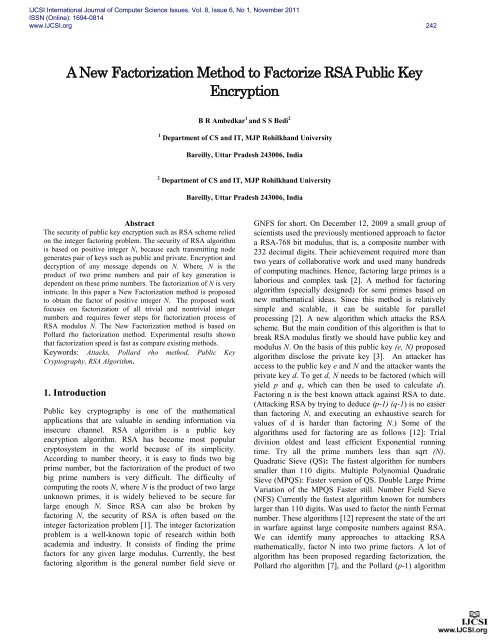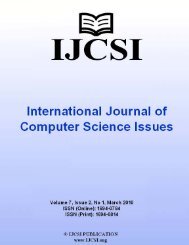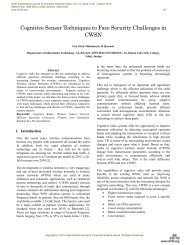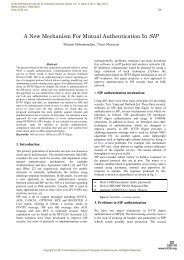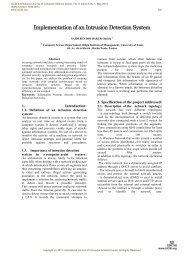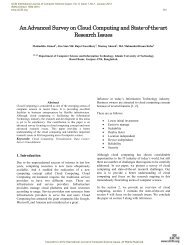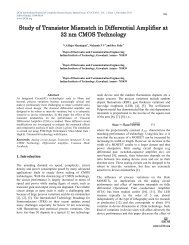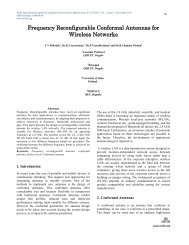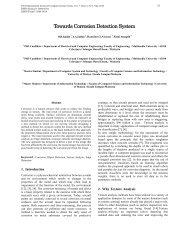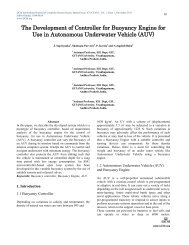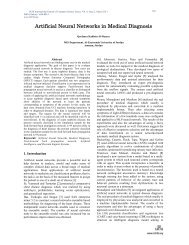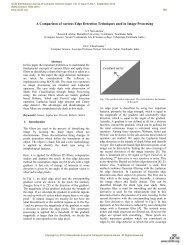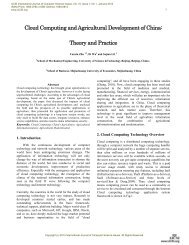A New Factorization Method to Factorize RSA Public Key ... - IJCSI
A New Factorization Method to Factorize RSA Public Key ... - IJCSI
A New Factorization Method to Factorize RSA Public Key ... - IJCSI
You also want an ePaper? Increase the reach of your titles
YUMPU automatically turns print PDFs into web optimized ePapers that Google loves.
<strong>IJCSI</strong> International Journal of Computer Science Issues, Vol. 8, Issue 6, No 1, November 2011<br />
ISSN (Online): 1694-0814<br />
www.<strong>IJCSI</strong>.org 242<br />
A <strong>New</strong> <strong>Fac<strong>to</strong>rization</strong> <strong>Method</strong> <strong>to</strong> Fac<strong>to</strong>rize <strong>RSA</strong> <strong>Public</strong> <strong>Key</strong><br />
Encryption<br />
B R Ambedkar 1 and S S Bedi 2<br />
1 Department of CS and IT, MJP Rohilkhand University<br />
Bareilly, Uttar Pradesh 243006, India<br />
2 Department of CS and IT, MJP Rohilkhand University<br />
Bareilly, Uttar Pradesh 243006, India<br />
Abstract<br />
The security of public key encryption such as <strong>RSA</strong> scheme relied<br />
on the integer fac<strong>to</strong>ring problem. The security of <strong>RSA</strong> algorithm<br />
is based on positive integer N, because each transmitting node<br />
generates pair of keys such as public and private. Encryption and<br />
decryption of any message depends on N. Where, N is the<br />
product of two prime numbers and pair of key generation is<br />
dependent on these prime numbers. The fac<strong>to</strong>rization of N is very<br />
intricate. In this paper a <strong>New</strong> <strong>Fac<strong>to</strong>rization</strong> method is proposed<br />
<strong>to</strong> obtain the fac<strong>to</strong>r of positive integer N. The proposed work<br />
focuses on fac<strong>to</strong>rization of all trivial and nontrivial integer<br />
numbers and requires fewer steps for fac<strong>to</strong>rization process of<br />
<strong>RSA</strong> modulus N. The <strong>New</strong> <strong>Fac<strong>to</strong>rization</strong> method is based on<br />
Pollard rho fac<strong>to</strong>rization method. Experimental results shown<br />
that fac<strong>to</strong>rization speed is fast as compare existing methods.<br />
<strong>Key</strong>words: Attacks, Pollard rho method, <strong>Public</strong> <strong>Key</strong><br />
Cryp<strong>to</strong>graphy, <strong>RSA</strong> Algorithm.<br />
1. Introduction<br />
<strong>Public</strong> key cryp<strong>to</strong>graphy is one of the mathematical<br />
applications that are valuable in sending information via<br />
insecure channel. <strong>RSA</strong> algorithm is a public key<br />
encryption algorithm. <strong>RSA</strong> has become most popular<br />
cryp<strong>to</strong>system in the world because of its simplicity.<br />
According <strong>to</strong> number theory, it is easy <strong>to</strong> finds two big<br />
prime number, but the fac<strong>to</strong>rization of the product of two<br />
big prime numbers is very difficult. The difficulty of<br />
computing the roots N, where N is the product of two large<br />
unknown primes, it is widely believed <strong>to</strong> be secure for<br />
large enough N. Since <strong>RSA</strong> can also be broken by<br />
fac<strong>to</strong>ring N, the security of <strong>RSA</strong> is often based on the<br />
integer fac<strong>to</strong>rization problem [1]. The integer fac<strong>to</strong>rization<br />
problem is a well-known <strong>to</strong>pic of research within both<br />
academia and industry. It consists of finding the prime<br />
fac<strong>to</strong>rs for any given large modulus. Currently, the best<br />
fac<strong>to</strong>ring algorithm is the general number field sieve or<br />
GNFS for short. On December 12, 2009 a small group of<br />
scientists used the previously mentioned approach <strong>to</strong> fac<strong>to</strong>r<br />
a <strong>RSA</strong>-768 bit modulus, that is, a composite number with<br />
232 decimal digits. Their achievement required more than<br />
two years of collaborative work and used many hundreds<br />
of computing machines. Hence, fac<strong>to</strong>ring large primes is a<br />
laborious and complex task [2]. A method for fac<strong>to</strong>ring<br />
algorithm (specially designed) for semi primes based on<br />
new mathematical ideas. Since this method is relatively<br />
simple and scalable, it can be suitable for parallel<br />
processing [2]. A new algorithm which attacks the <strong>RSA</strong><br />
scheme. But the main condition of this algorithm is that <strong>to</strong><br />
break <strong>RSA</strong> modulus firstly we should have public key and<br />
modulus N. On the basis of this public key (e, N) proposed<br />
algorithm disclose the private key [3]. An attacker has<br />
access <strong>to</strong> the public key e and N and the attacker wants the<br />
private key d. To get d, N needs <strong>to</strong> be fac<strong>to</strong>red (which will<br />
yield p and q, which can then be used <strong>to</strong> calculate d).<br />
Fac<strong>to</strong>ring n is the best known attack against <strong>RSA</strong> <strong>to</strong> date.<br />
(Attacking <strong>RSA</strong> by trying <strong>to</strong> deduce (p-1) (q-1) is no easier<br />
than fac<strong>to</strong>ring N, and executing an exhaustive search for<br />
values of d is harder than fac<strong>to</strong>ring N.) Some of the<br />
algorithms used for fac<strong>to</strong>ring are as follows [12]: Trial<br />
division oldest and least efficient Exponential running<br />
time. Try all the prime numbers less than sqrt (N).<br />
Quadratic Sieve (QS): The fastest algorithm for numbers<br />
smaller than 110 digits. Multiple Polynomial Quadratic<br />
Sieve (MPQS): Faster version of QS. Double Large Prime<br />
Variation of the MPQS Faster still. Number Field Sieve<br />
(NFS) Currently the fastest algorithm known for numbers<br />
larger than 110 digits. Was used <strong>to</strong> fac<strong>to</strong>r the ninth Fermat<br />
number. These algorithms [12] represent the state of the art<br />
in warfare against large composite numbers against <strong>RSA</strong>.<br />
We can identify many approaches <strong>to</strong> attacking <strong>RSA</strong><br />
mathematically, fac<strong>to</strong>r N in<strong>to</strong> two prime fac<strong>to</strong>rs. A lot of<br />
algorithm has been proposed regarding fac<strong>to</strong>rization, the<br />
Pollard rho algorithm [7], and the Pollard (p-1) algorithm
<strong>IJCSI</strong> International Journal of Computer Science Issues, Vol. 8, Issue 6, No 1, November 2011<br />
ISSN (Online): 1694-0814<br />
www.<strong>IJCSI</strong>.org 243<br />
[8], Brent's method [9], are probabilistic, and may not<br />
finish, for small values of N, Trial division algorithm [12]<br />
and Fermat method can finish [11]. In this paper we are<br />
proposing <strong>New</strong> <strong>Fac<strong>to</strong>rization</strong> (NF) method which is based<br />
on Pollard rho <strong>Fac<strong>to</strong>rization</strong> (PRF) method [7]. By using<br />
NF method we can fac<strong>to</strong>rize quickly all integer number. It<br />
is very suitable for fac<strong>to</strong>rization against <strong>RSA</strong> algorithms,<br />
because that have a product of two prime number, so there<br />
is no more than two fac<strong>to</strong>rs, NF method fac<strong>to</strong>rize all<br />
numbers with minimum elapsed time shown in Fig. 1.<br />
MATLAB environment is used for various analyses.<br />
2. Attacks<br />
The security of the <strong>RSA</strong> cryp<strong>to</strong>system is not perfect. An<br />
attacker can resort <strong>to</strong> different approaches <strong>to</strong> attack <strong>RSA</strong><br />
algorithm. Among them, Brute force, Mathematical attacks,<br />
Timing attacks and Chosen Cipher text attacks are<br />
described in following:<br />
2.1 Brute Force Attacks on <strong>RSA</strong><br />
Brute force attacks, involves trying all possible public and<br />
private keys. The attacker tries all possible combinations <strong>to</strong><br />
guess the private key. <strong>RSA</strong> with short secret key is proven<br />
insecure against brute force attack [13]. This attack can be<br />
easily circumvented by choosing large key. However, the<br />
larger key will make the encryption and decryption process<br />
little slow as it will require greater computations in key<br />
generation as well as in encryption/decryption algorithm.<br />
The key length used in the encryption determines the<br />
practical feasibility of performing a brute-force attack,<br />
with longer keys exponentially more difficult <strong>to</strong> crack than<br />
shorter ones. Brute-force attacks can be made less effective<br />
by obfuscating the data <strong>to</strong> be encoded, something that<br />
makes it more difficult for an attacker <strong>to</strong> recognize when<br />
he/she has cracked the code. One of the measures of the<br />
strength of an encryption system is how long it would<br />
theoretically take an attacker <strong>to</strong> mount a successful bruteforce<br />
attack against it.<br />
2.2 Mathematical Attacks on <strong>RSA</strong><br />
Mathematical attacks focus on attacking the underlying<br />
structure of <strong>RSA</strong> function. The first intuitive attack is the<br />
attempt <strong>to</strong> fac<strong>to</strong>r the modulus N. There are several<br />
approaches, all equivalent <strong>to</strong> in effect <strong>to</strong> fac<strong>to</strong>ring the<br />
product of two primes N. Our objective is <strong>to</strong> provide <strong>RSA</strong><br />
attacks that decrypts message by fac<strong>to</strong>ring N.<br />
2.3 Timing Attack<br />
In <strong>RSA</strong>, the attacker can exploit the timing variation of the<br />
modular exponentiation implementations and able <strong>to</strong><br />
determine d by calculating the time it takes <strong>to</strong> compute<br />
C d (mod N) for a given cipher text C [13].<br />
2.4 <strong>Fac<strong>to</strong>rization</strong> Attack<br />
The security of RAS is based on the idea that the modulus<br />
is so large that is infeasible <strong>to</strong> fac<strong>to</strong>r it in reasonable time.<br />
Bob selects P and Q and calculate N=P×Q. Although N is<br />
public, P and Q are secret. If Eve can fac<strong>to</strong>r N and obtain<br />
P and Q, Eve then can calculate d = e -1 mod φ(N) because<br />
e is public. The private exponent d is the trapdoor that Eve<br />
uses <strong>to</strong> decrypt any encrypted message.<br />
The fac<strong>to</strong>rization attack is a extremely giant dispute for<br />
security of <strong>RSA</strong> algorithm. Some existing fac<strong>to</strong>rization<br />
algorithms can be generating public and private key of<br />
<strong>RSA</strong> algorithm, by fac<strong>to</strong>rization of modulus N. But they<br />
are taking huge time for fac<strong>to</strong>rization of N, in case of P<br />
and Q very large. We are focusing on fac<strong>to</strong>rization speed<br />
and proposing new fac<strong>to</strong>rization method <strong>to</strong> enhance the<br />
speed of fac<strong>to</strong>rization. Related works for fac<strong>to</strong>rization of<br />
modulus N are following.<br />
3. Related Work<br />
The <strong>RSA</strong> Fac<strong>to</strong>ring Challenge was started in March 1991<br />
by <strong>RSA</strong> Data Security <strong>to</strong> keep abreast of the state of the art<br />
in fac<strong>to</strong>ring. Since its inception, well over a thousand<br />
numbers have been fac<strong>to</strong>red, with the fac<strong>to</strong>ries returning<br />
valuable information on the methods they used <strong>to</strong> complete<br />
the fac<strong>to</strong>rizations. The Fac<strong>to</strong>ring Challenge provides one<br />
of the largest test-beds for fac<strong>to</strong>ring implementations and<br />
provides one of the largest collections of fac<strong>to</strong>ring results<br />
from many different experts worldwide. In short, this vast<br />
pool of information gives us an excellent opportunity <strong>to</strong><br />
compare the effectiveness of different fac<strong>to</strong>ring techniques<br />
as they are implemented and used in practice. Since the<br />
security of the <strong>RSA</strong> public-key cryp<strong>to</strong>system relies on the<br />
inability <strong>to</strong> fac<strong>to</strong>r large numbers of a special type, the<br />
cryp<strong>to</strong>graphic significance of these results is self-evident.<br />
Some fac<strong>to</strong>rization methods are explored in following<br />
paragraphs:<br />
J. Carlos et al [2] proposed a method for fac<strong>to</strong>ring<br />
algorithm is: gcd [N, (k . Ň) + ∆] and gcd [N, (k . Ň) – ∆]<br />
result in nontrivial fac<strong>to</strong>rs of N for different values of ∆<br />
where Ň is the reverse of N and k is a positive integer<br />
ranging from one <strong>to</strong> infinity.<br />
Sattar J Aboud [3] was introducing a method that breaking<br />
the <strong>RSA</strong> scheme based on the knowing public key (e, N).<br />
This method will work efficiently if the decryption key d is<br />
small. It possible therefore, <strong>to</strong> fac<strong>to</strong>r the modulus N.
<strong>IJCSI</strong> International Journal of Computer Science Issues, Vol. 8, Issue 6, No 1, November 2011<br />
ISSN (Online): 1694-0814<br />
www.<strong>IJCSI</strong>.org 244<br />
L. Scripcariu, M.D. Frunze [4] was commencing some<br />
weak points of <strong>RSA</strong> algorithm and proposed a method for<br />
secure public key. The main concept of this paper is for<br />
encryption (e, N) change every time public key for<br />
encryption.<br />
In 1978, <strong>RSA</strong> developed a public key cryp<strong>to</strong>system that is<br />
based on the difficulty of integer fac<strong>to</strong>ring. The <strong>RSA</strong><br />
public key encryption scheme is the first example of a<br />
provable secure public key encryption scheme against<br />
chosen message chosen attacks [5].The <strong>RSA</strong> scheme is as<br />
follows [6]:<br />
<strong>Key</strong> generation algorithm, <strong>to</strong> generate the keys entity<br />
A must do the following:<br />
1. Randomly and secretly select two large prime<br />
numbers p and q.<br />
2. Compute the N=p*q.<br />
3. Compute (φ) phi (N) = (p-1) (q-1).<br />
4. Select random integer e, 1
<strong>IJCSI</strong> International Journal of Computer Science Issues, Vol. 8, Issue 6, No 1, November 2011<br />
ISSN (Online): 1694-0814<br />
www.<strong>IJCSI</strong>.org 245<br />
N), gcd (X i – X j, N) > 1, and gcd (X i – X j, N)|N. Therefore<br />
gcd (X i – X j, N) is a nontrivial fac<strong>to</strong>r of N.<br />
Example 3:<br />
Consider the Pollard rho algorithm for N = 21 = 7*3.<br />
The sequence of Xn values generated by the algorithm is:<br />
X 0 =2, X 1 =5, X 2 =5,………, for n≥1,<br />
If n ≥ 1, X 2n - X n =0.<br />
The algorithm at each step for n = 1,2,…<br />
Compute gcd (X 2n – X n ,N) = gcd (0, , 21) =21<br />
We are showing this example, the Pollard rho algorithm is<br />
a probabilistic, and may not finish, even for small values of<br />
N.<br />
5. <strong>New</strong> <strong>Fac<strong>to</strong>rization</strong> <strong>Method</strong><br />
The new fac<strong>to</strong>rization method (NF) based on Pollard rho<br />
method and square root of N. The NF method is focusing<br />
on Mathematical and <strong>Fac<strong>to</strong>rization</strong> Attacks on <strong>RSA</strong>.<br />
Shown in e.g. 3, the Pollard rho fac<strong>to</strong>rization method may<br />
not finish small value of N. We are using <strong>RSA</strong> algorithm<br />
for public key cryp<strong>to</strong>graphy, it is asymmetric encryption<br />
technique, by using this technique we cannot encrypt and<br />
decrypt message by same key. The generation of public<br />
and private key is dependent on the fac<strong>to</strong>rization of N. By<br />
using Pollard rho fac<strong>to</strong>rization method, we can’t fac<strong>to</strong>rize<br />
all integer numbers N see e.g. 3. By using NF method we<br />
fac<strong>to</strong>rize all integer numbers N. The NF method is a<br />
independent of periodic sequence and probabilistic method.<br />
For fac<strong>to</strong>rization of all integer number, we are proposing<br />
<strong>to</strong> Pollard rho fac<strong>to</strong>rization method <strong>to</strong> modifying and<br />
removing the concept of periodic sequence. NF method as<br />
follows:<br />
1. Let any positive integer is N.<br />
2. Compute the square root of N.<br />
3. Take ceiling function of step two.<br />
4. Decrement by one in square of step three.<br />
5. Compute the greatest Common divisor of step<br />
three and step number one.<br />
6. If step five is grater than one.<br />
7. Step five is a fac<strong>to</strong>r of step one.<br />
8. Compute other fac<strong>to</strong>r of N divided by step seven.<br />
9. Otherwise increment the value of steps three by<br />
one and continues step three <strong>to</strong> eight, till step four<br />
is grater than one.<br />
By using these steps we fac<strong>to</strong>rize any positive integer as<br />
follows:<br />
Example 4:<br />
Let N=21<br />
S=5<br />
P=gcd(24,21)=3>1<br />
Q=21/3=7<br />
P and Q is fac<strong>to</strong>r of N.<br />
Example5:<br />
Let N= 999962000357<br />
Decimal digits=12 Bits= 40<br />
S= 999981<br />
P=gcd (999962000360, 999962000357) = 1<br />
P=gcd (999964000323, 999962000357) = 999983>1<br />
Q= 999962000357/999983=999979<br />
P and Q is a fac<strong>to</strong>r of N.<br />
6. Simulation and Results<br />
We are fac<strong>to</strong>rized all trivial and nontrivial number shown<br />
in e.g. 4. The NF method is a appropriate and essential for<br />
fac<strong>to</strong>rization of product of any two prime numbers because<br />
that have only two fac<strong>to</strong>rs as shown in simulated result Fig.<br />
1, fac<strong>to</strong>rs of 14 decimal digit by using NF method elapsed<br />
time is 94ms shown in Fig. 1. That domino effect<br />
simulated by MATLAB version 7.0 and Intel(R),<br />
Core(TM)2 Quad CPU 2.66GHz, 3.24 GB of RAM. As<br />
per the results shows fac<strong>to</strong>rization becomes more rapidly<br />
by NF method.<br />
Fig. 1 Fac<strong>to</strong>rs of 80964686104403 by using NF method ( Elapsed time<br />
in sec.= 0.094) simulation shows.<br />
The elapsed time for prime fac<strong>to</strong>rization shown in Fig. 2<br />
with respect digits and Fig. 3 with respect bits process<br />
elapsed times is awfully tiny as compare <strong>to</strong> existing<br />
method.
<strong>IJCSI</strong> International Journal of Computer Science Issues, Vol. 8, Issue 6, No 1, November 2011<br />
ISSN (Online): 1694-0814<br />
www.<strong>IJCSI</strong>.org 246<br />
5<br />
4.5<br />
4<br />
5<br />
4.5<br />
4<br />
Elapsed time (in sec.) vs Digits in Prime Fac<strong>to</strong>rs<br />
Elapsed time(in sec.) y<br />
3.5<br />
3<br />
2.5<br />
2<br />
1.5<br />
1<br />
0.5<br />
Elapsed Time (in second) y<br />
3.5<br />
3<br />
2.5<br />
2<br />
1.5<br />
1<br />
0.5<br />
0<br />
1 2 3 4 5 6 7 8 9 10 11 12 13 14<br />
Decimal Digits in Prime Fac<strong>to</strong>rs x<br />
1 2 3 4 5 6 7<br />
Decimal Digits in Prime Fac<strong>to</strong>rsx<br />
Fig. 2 NF method(Elapsed time vs Decimal digits in prime fac<strong>to</strong>rs)<br />
Fig. 4 Pollard rho method (Elapsed time vs Decimal digits in prime<br />
fac<strong>to</strong>rs)<br />
Elapsed Time (in second) y<br />
5<br />
4.5<br />
4<br />
3.5<br />
3<br />
2.5<br />
2<br />
1.5<br />
Elapsed time in second vs Number bits of prime fac<strong>to</strong>rs<br />
Table 1 shows a comparison of some fac<strong>to</strong>rization methods<br />
vs NF method, The trial division, Fermat fac<strong>to</strong>rization<br />
method and NF method always terminate, and upper<br />
bounds can be derived for the running times of these<br />
algorithms in terms of N, the number <strong>to</strong> be fac<strong>to</strong>red. The<br />
Pollard rho algorithm, Brent's method, and the Pollard p-<br />
1algorithm are probabilistic, and may not finish, even for<br />
small values of N.<br />
Table 1: Comparison of few fac<strong>to</strong>rization methods vs MPRF method<br />
<strong>Fac<strong>to</strong>rization</strong><br />
<strong>Method</strong><br />
For all<br />
numbers<br />
Technique used<br />
1<br />
0.5<br />
5 10 15 20 25 30 35 40 45 50<br />
Number of bitsx<br />
Fig. 3 NF method(Elapsed time vs Total number of Bits of prime fac<strong>to</strong>rs)<br />
Shown in Fig. 4, a plot of time elapsed and number of<br />
digits for given number by using traditional existing<br />
Pollard rho, the fac<strong>to</strong>rization of 7 digit decimal number<br />
elapsed time is 0.5s.<br />
Trial Can fac<strong>to</strong>rize Division based<br />
Fermat Can fac<strong>to</strong>rize N=x 2 -y 2<br />
Pollard Rho Can’t fac<strong>to</strong>rize Periodic sequences<br />
Pollard (p-1) Can’t fac<strong>to</strong>rize (a k! -1) mod n<br />
Brent's Can‘t fac<strong>to</strong>rize X n+1 =X 2 n +2(mod<br />
NF Fac<strong>to</strong>rize Square root<br />
N)<br />
based<br />
The shown in Fig. 5 comparison between existing<br />
algorithms and NF method. The fac<strong>to</strong>rization of 7 digit<br />
decimal number by NF method the elapsed time is 0.032s.<br />
NF method produced all fac<strong>to</strong>rs of any integer number.<br />
The algorithm was executed using MATLAB <strong>to</strong>ol.
<strong>IJCSI</strong> International Journal of Computer Science Issues, Vol. 8, Issue 6, No 1, November 2011<br />
ISSN (Online): 1694-0814<br />
www.<strong>IJCSI</strong>.org 247<br />
Elapsed time (in sec.)<br />
1000<br />
Ellapsed time (in sec.) vs Number of<br />
digits in prime fac<strong>to</strong>rs<br />
100<br />
10<br />
1<br />
0.1<br />
0.01<br />
1 2 3 4 5 6 7<br />
Number of digits<br />
Trial Division<br />
Fermat<br />
<strong>Fac<strong>to</strong>rization</strong><br />
Pollard rho method<br />
N F method<br />
Fig. 5 Number of digits vs. Elapsed time in Prime Fac<strong>to</strong>rs<br />
7. Conclusions<br />
In this paper <strong>New</strong> <strong>Fac<strong>to</strong>rization</strong> method is proposed for<br />
<strong>RSA</strong> modulus N fac<strong>to</strong>rization. During simulation, Pollard<br />
rho fac<strong>to</strong>rization method is found not suitable <strong>to</strong> fac<strong>to</strong>r all<br />
trivial numbers as shown in example 3. Although NF<br />
method fac<strong>to</strong>rizes all the integer numbers as described in<br />
example 4. The elapsed time with respect <strong>to</strong> decimal digits<br />
in prime fac<strong>to</strong>rs is found less as compared <strong>to</strong> considered<br />
existing methods. The speed <strong>to</strong> compute the prime fac<strong>to</strong>rs<br />
is also found more as compare <strong>to</strong> existing methods.<br />
Therefore the proposed method is relatively simple, fast<br />
and scalable as compare <strong>to</strong> existing methods.<br />
References<br />
[1] Hung-Min Sun, Mu-En Wu, Wei-Chi Ting, and M. Jason<br />
Hinek, “Dual <strong>RSA</strong> and Its Security Analysis”, IEEE<br />
Transactions on Information Theory, Vol. 53, No. 8, Aug.<br />
2007.<br />
[2] Joao Carlos Leandro da Silva, “Fac<strong>to</strong>ring Semi primes and<br />
Possible Implications”, IEEE in Israel, 26 th Convention, pp.<br />
182-183, Nov. 2010.<br />
[3] Sattar J Aboud, “An efficient method for attack <strong>RSA</strong><br />
scheme”, ICADIWT Second International Conference, pp<br />
587-591,4-6 Aug 2009.<br />
[4] L. Scripcariu, M.D. Frunza, "A <strong>New</strong> Character Encryption<br />
Algorithm", ICMCS 2005, pp. 83 - 86, Sept., 2005.<br />
[5] Hongwei Si et al, “An Improved <strong>RSA</strong> Signature Algorithm<br />
based on Complex Numeric Operation Function”,<br />
International Conference on Challenges in Environmental<br />
Science and Computer Engineering , vol. 2, pp. 397-400,<br />
2010.<br />
[6] B. Schneier, Applied cryp<strong>to</strong>graphy, second edition, NY: John<br />
Wiley & Sons, Inc., 1996.<br />
[7] J. Pollard, "Monte Carlo methods for index computation<br />
(mod p)",Math. Comp., Vol. 32, pp.918-924, 1978.<br />
[8] J. Pollard, "Theorems on fac<strong>to</strong>rization and primality testing",<br />
Proc. Cambridge Philos.Soc., Vol. 76, pp.521-528, 1974.<br />
[9] R. P. Brent, “An improved Monte Carlo fac<strong>to</strong>rization<br />
algorithm”, BIT 20 (1980), 176-184. MR 82a:10007, Zbl<br />
439.65001. rpb051.<br />
[10] R. Rivest, A. Shamir, L. Adleman, "A <strong>Method</strong> for Obtaining<br />
Digital for Signatures and <strong>Public</strong>-<strong>Key</strong> Cryp<strong>to</strong>systems",<br />
Communications of the ACM, vol. 21 (2), pp. 120-126,<br />
1978.<br />
[11] Bell, E. T., “The Prince of Amateurs: Fermat.” <strong>New</strong> York:<br />
Simon and Schuster, pp. 56-72, 1986.<br />
[12] Ms. Divya Bansal, Ajay Goel, “Interrelation Among <strong>RSA</strong><br />
Security, Strong Primes, and Fac<strong>to</strong>ring”<br />
[13] M. Wiener, “Cryptanalysis of short rsa secret<br />
exponents”,IEEE Transactions on Information Theory,<br />
160:553–558, March 1990.<br />
Bhagwant Ram Ambedkar received the B.<br />
Tech. Degree in Electronics Engineering from<br />
Institute of Engineering and Technology Lucknow,<br />
India in 2001 and M. Tech. with specialization in<br />
Wireless Communication and Computing from<br />
Indian Institute of Information Technology,<br />
Allahabad, India in 2004. Presently he is working<br />
as Assistant Professor in Department of Computer<br />
Science and Information Technology, MJP<br />
Rohilkhand University Bareilly, Uttar Pradesh,<br />
India.<br />
Dr. Sarabjeet Singh Bedi received the M.E.<br />
degree in Computer Science and Engineering from<br />
Thapar Institute of Engineering and Technology,<br />
Punjab, India in 2002. He has received his Ph.D.<br />
from Indian Institute of Information Technology<br />
and Management, Gwalior, India. He has teaching<br />
and research experience of 16 years. His research<br />
interest is Network Management and Security.<br />
Currently He is teaching at M.J.P. Rohilkhnad<br />
University, Bareilly, India. He is involved in<br />
various academic and research activities. He is<br />
member of selection, advisor, governing and<br />
technical committees of various Universities and<br />
Technical Institution bodies. Dr. S. S. Bedi<br />
received Institute Medal from TIET, Punjab, India,<br />
2002, Rastriya Shikshak Ratan Award from<br />
AIBDA, <strong>New</strong> Delhi in 2002 and Best Paper award<br />
at World Congress on Engineering at London,<br />
2008.


